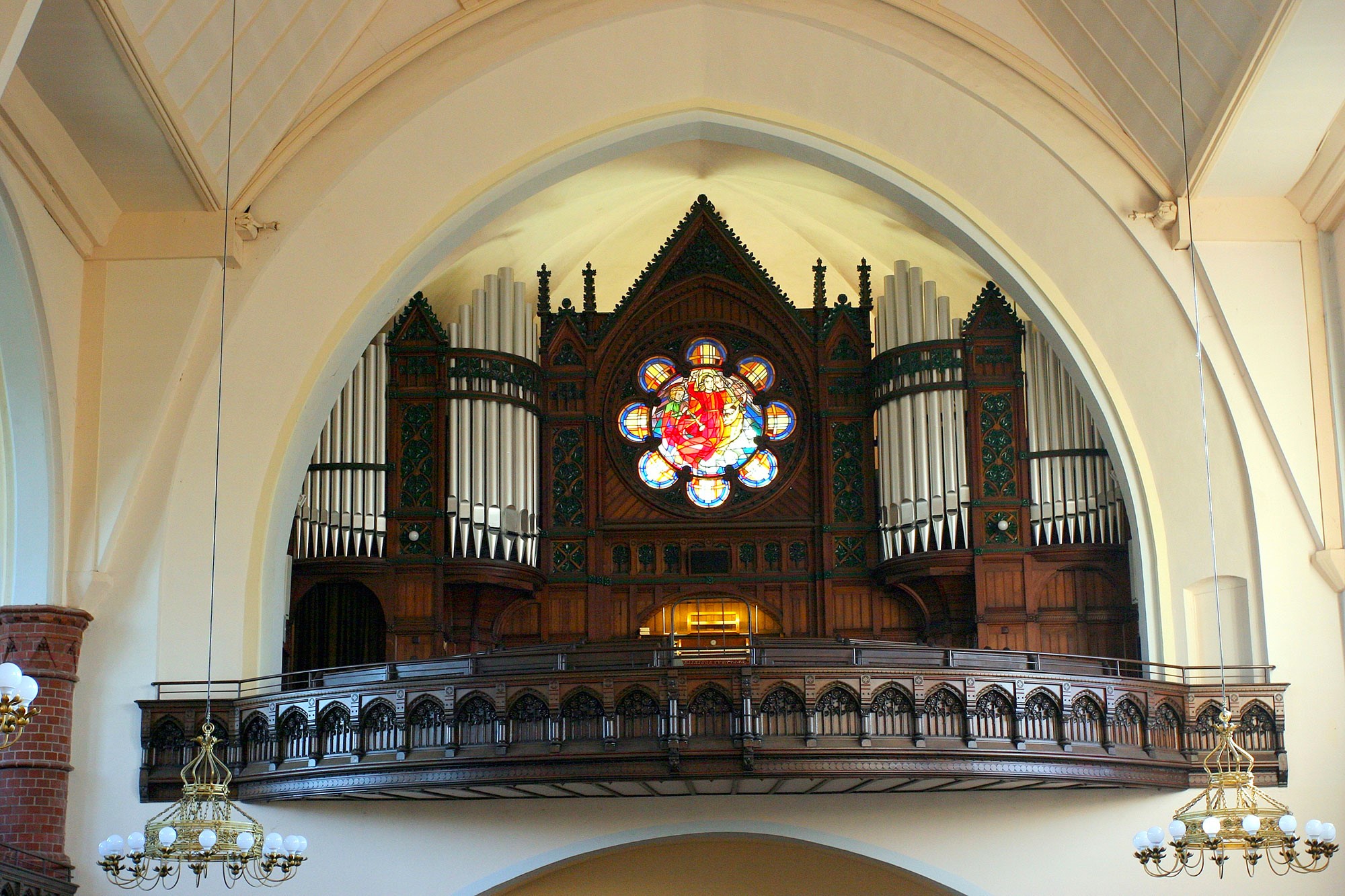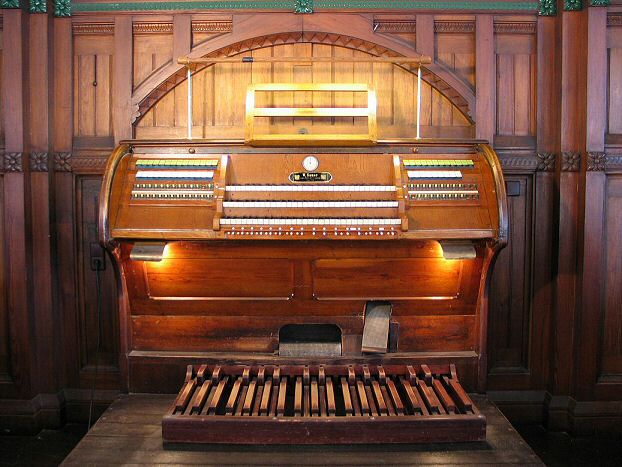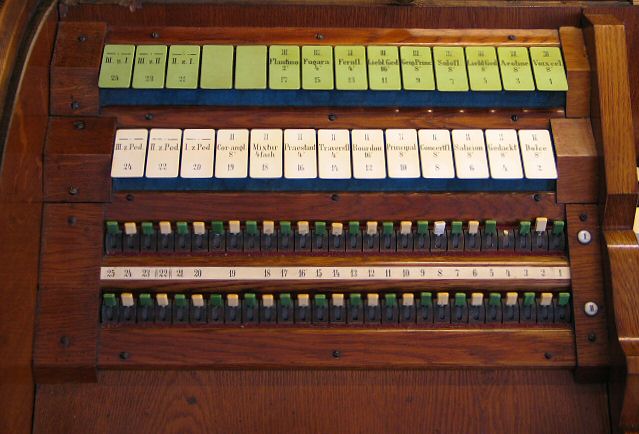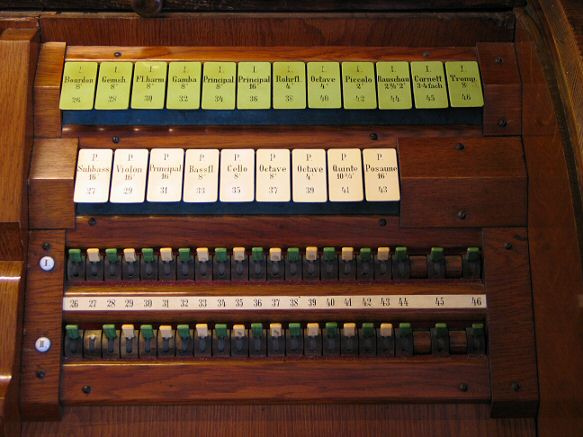Gronau, Evangelische Stadtkirche
| Builder | W. Sauer |
|---|---|
| Year | 1904 |
| Period/Style | Romantic |
| Stops | 40 |
| Keyboards | 3+P |
| Keyaction | pneumatic |
| Tuning | Equal at 440 Hz |
| Sampleset |
Available
 , sampled by
OrganArt Media
, sampled by
OrganArt Media
|
The 1904 Wilhelm Sauer Organ, op. 915, installed in the city church of Gronau in North Germany, is an exemplar of late Romantic organ craftsmanship. This three-manual, 40-register organ was built to serve the burgeoning population of the Ruhr region, historically Germany's largest coal-mining area. Remarkably, it has survived virtually intact through four major calamities: both World Wars, the German organ reform movement, and a devastating church fire caused by a lightning strike that resulted in the tower collapsing into the church. Up until 2017, the pipe organ stood in the church of Dortmund-Dorstfeld. The organ's original pipes, particularly the Principal 16 made of zinc, are thought to be authentic and untouched by wartime requisitions, suggesting they could have been part of the initial construction, as zinc was commonly used before World War I.
Wilhelm Sauer, often referred to as the "German Cavaillé-Coll," was profoundly influenced by his year as a volunteer in the Cavaillé-Coll workshop around 1852. Sauer's organ-building philosophy was significantly shaped by Cavaillé-Coll's ideas, integrating French organ concepts into German designs. His organs are known for their symphonic sound, mirroring the late Romantic symphony orchestra, with a focus on quality overblown pipes that produce a rich, orchestral timbre. Unlike Baroque organs, Sauer's instruments were designed with numerous 8-foot registers to allow for a vast spectrum of sound mixtures, aiming for orchestral colors with crowning mixtures that support rather than dominate the musical texture. The Sauer Organ op. 915 exemplifies these principles, offering a dynamic range from the softest pianissimos to the powerful fortissimos required for the music of Max Reger, highlighting the organ's capability to render complex late Romantic compositions effectively. In 2017, this historic organ was relocated to Gronau, ensuring its preservation and continued use.
Wilhelm Sauer, often referred to as the "German Cavaillé-Coll," was profoundly influenced by his year as a volunteer in the Cavaillé-Coll workshop around 1852. Sauer's organ-building philosophy was significantly shaped by Cavaillé-Coll's ideas, integrating French organ concepts into German designs. His organs are known for their symphonic sound, mirroring the late Romantic symphony orchestra, with a focus on quality overblown pipes that produce a rich, orchestral timbre. Unlike Baroque organs, Sauer's instruments were designed with numerous 8-foot registers to allow for a vast spectrum of sound mixtures, aiming for orchestral colors with crowning mixtures that support rather than dominate the musical texture. The Sauer Organ op. 915 exemplifies these principles, offering a dynamic range from the softest pianissimos to the powerful fortissimos required for the music of Max Reger, highlighting the organ's capability to render complex late Romantic compositions effectively. In 2017, this historic organ was relocated to Gronau, ensuring its preservation and continued use.
| Manual I | Manual II | Manual III | Pedal |
|---|---|---|---|
| Principal 16' | Bourdon 16' | Lieblich Gedackt 16' | Principal 16' |
| Principal 8' | Principal 8' | Geigenprincipal 8' | Violon 16' |
| Bourdon 8' | Gedackt 8' | Lieblich Gedackt 8' | Subbaß 16' |
| Flûte Harmonique 8' | Concertflöte 8' | Soloflöte 8' | Quinte 10 2/3' |
| Gamba 8' | Salicional 8' | Aeoline 8' | Octave 8' |
| Gemshorn 8' | Dolce 8' | Voix Céleste 8' | Baßflöte 8' |
| Octave 4' | Praestant 4' | Fugara 4' | Cello 8' |
| Rohrflöte 4' | Traversflöte 4' | Fernflöte 4' | Octave 4' |
| Piccolo 2' | Mixtur 4fach | Flautino 2' | Posaune 16' |
| Rauschquinte 2f | Cor Anglais 8' | ||
| Cornett 3-4fach | |||
| Trompete 8' |
Reger-Toccata-op.595
0:00
0:00
Rheinberger op98-1
0:00
0:00
Franck-Pastorale
0:00
0:00
Reger-Romanze-op.808
0:00
0:00
https://www.organartmedia.com/de/wilhelm-sauer
 Pipe Organ Map
Pipe Organ Map


